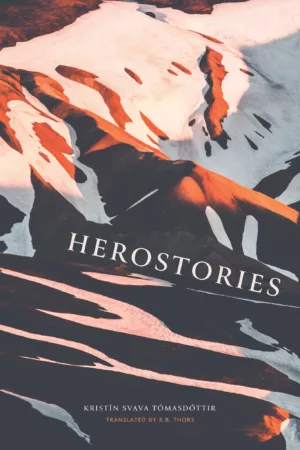Herostories
by Kristín Svava Tómasdóttir, translated by K. B. Thors
reviewed by Katy Dycus
Icelandic author Krístin Svava Tómasdóttir is a poet and historian living in Reykajavík. Her latest book, Herostories, translated by K. B. Thors, meets at the intersection of poetry and history, in a unique work that synthesizes elements of folklore, national history, and Icelandic women’s struggle for independence. The poems of Herostories, presented in bilingual format, are composed entirely of text found in Íslenskar ljósmæður I–III (Icelandic Midwives I–III), volumes of short biographical sketches about Icelandic midwives working from the late eighteenth to early twentieth centuries.
Midwifery is the oldest profession of women in Iceland, as midwives were the first women to work outside the home and receive a salary. It wasn’t until 1911 that Icelandic women were allowed to become doctors, so midwifery was the closest they could get. The story of midwives reflects a larger struggle for education and independence, led by women with a
longing for broader horizons
longing for a change of scenery
longing to leave home
longing to be something more than a cook
The midwives whose history Tómasdóttir retells faced many obstacles. If there were complications in childbirth, the doctor would be the first to be called upon, but if he could not make it in time, it was the midwife’s responsibility “to overcome every problem / with two sometimes three lives in hand.” In homes with no heating or floor and ceiling panels, and nothing but frozen oatmeal to feed a newborn baby, the midwife was a woman’s guardian angel: “She bore the light with her / safety and warmth / followed her.”
In 1924, the professional name of the midwife was even registered as Ljósmóðir: “Mother of Light.” But light was oftentimes overshadowed by the darkness of night and long, black winters. This was a time before electricity and telephones, before C-sections and epidurals, before paved roads and bridges, when “strength and stamina mattered more.” The midwife was often called upon in the night, forced to leave her own crying babies to journey across a perilous landscape, for “everyone knows women like to go into labour / during the deadliest blizzards / and usually at night.”
Tómasdóttir presents, through repetition, ideas about the idealization of womanly virtues and feminine labor, all while magnifying those characterizations to excess. Translator K. B. Thors coins words like “bodilyendurance,” “selfsacrifice,” and “workjoy” that compound and complicate these qualities, while mirroring the compound nature of Icelandic words themselves. Compound words are piled on to describe the weather: “impassableslog,” “snowcoffin,” “skinstinging,” “blindingblizzards,” “extremedark,” “wickedweather.” The effect is menacing, like the phenomena the words evoke.
In Iceland, there are many words for weather, all of them region-specific. You can find over 130 words in the Icelandic language for wind alone. Artist Sólrún Halldórsdóttir chose 112 of these to include in her environmental sculpture Vedurhorfur; by selecting 112 words, she is dialing the Icelandic equivalent of 9-1-1, while invoking the idea that Icelanders’ livelihood and survival have always depended on the weather.
Tómasdóttir admits that each of her books has become more preoccupied with weather than the last; her 2018 book, Stormwarning, leaves the reader in anticipation of a coming storm. In Herostories, weather becomes the midwife’s epic adversary. Her exceptional strength seems to elevate her to she-troll status within the Icelandic saga tradition, as she seeks to defeat the most formidable foe: Iceland’s punishing landscape.
Relentless she pressed against the storm
sat mannish astride her sidesaddle and set off unshrinking
out in deep and heavy current
out in the raging torrent
The midwife surmounts treacherous mountain ways, glaciers, lava-obstructed rivers, deep craters, swamps, sheer landslides, and precipitous sea-cliffs. She presses on when her steed lies buried in a snowdrift, even when her male guides turn back. Here was “the woman with the hot heart that melted ice and snow / the woman with the steelwill that soothed wind and water.”
But the dangers are real. Tómasdóttir includes two poems in the book about the deaths of midwives killed on the job—one by an avalanche, the other by drowning in a river. Tómasdóttir classifies these stories as part of an Icelandic literary genre called þjóðlegur fróðleikur, a kind of folk history set among dangerous, often deadly, travels in the Icelandic wilderness. This traditionally male form of storytelling is reimagined to tell the story of midwives—of the women who birthed a nation. Tómasdóttir urges us to omit the “o” from Herostories to make it Her(o)stories: “The heroics of a woman on a trying path.” Her stories become legend.
Published on June 6, 2023

